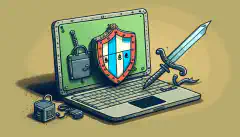Cybersecurity in Remote Work: A Comprehensive Guide.

Table of Contents
As the world continues to adapt to the ongoing pandemic, remote work has become the norm for many organizations. While remote work has many benefits, it also comes with unique cybersecurity challenges. With employees working from home or other remote locations, the traditional security measures that organizations have in place may not be enough to protect sensitive information. In this article, we’ll discuss the role of cybersecurity in the era of remote work and provide a comprehensive guide for organizations to ensure their remote workforce stays secure.
The Challenges of Remote Work
Before we dive into the specifics of cybersecurity in the era of remote work, it’s important to understand the challenges that come with remote work in general. When employees are working from home or other remote locations, they are not operating within the secure network of their organization. This means that their personal devices may not have the same level of security as the devices provided by their organization. Additionally, remote workers may be using public Wi-Fi networks that are not secure, putting sensitive information at risk.
Importance of Cybersecurity in Remote Work
Cybersecurity has always been important for organizations, but it’s even more critical in the era of remote work. With employees working from various locations and using their personal devices, there are more opportunities for cybercriminals to access sensitive information. Organizations that do not have the proper cybersecurity measures in place may be at risk of data breaches, which can be costly and damaging to their reputation. Therefore, it’s essential for organizations to prioritize cybersecurity in their remote work strategy.
Best Practices for Cybersecurity in Remote Work
Now that we understand the importance of cybersecurity in remote work, let’s discuss some best practices for keeping remote workers and sensitive information secure.
Use Secure Communication Channels
One of the challenges of remote work is the risk of exposing sensitive information while communicating through unsecured channels. Using secure communication channels ensures that remote workers are protected.
Encrypted messaging apps like Signal, Telegram, and WhatsApp are good options for secure communication. These apps offer end-to-end encryption, which means that only the sender and receiver can read the messages. This ensures that sensitive information is not exposed to unauthorized parties. This is a general recommendation. For larger enterprises you should Probably Stick with Microsoft Teams or other secure messing apps.
Video conferencing tools like Zoom and Microsoft Teams are also great options for secure communication. These tools offer features like end-to-end encryption, which ensures that sensitive information is protected during video calls.
To ensure that remote workers are using secure communication channels, organizations should provide training on the proper use of these tools. Remote workers should be aware of the risks associated with using unsecured channels and how to identify and avoid them.
Overall, using secure communication channels is an essential aspect of remote work cybersecurity. It’s important for organizations to ensure that their remote workforce is trained on the proper use of these tools and understands the risks associated with unsecured channels.
Provide Secure Devices
Providing employees with secure devices is critical for remote work cybersecurity. These devices should have the necessary security measures in place, such as firewalls and antivirus software. By providing employees with company-owned devices, organizations can ensure that these security measures are in place and that the devices are regularly updated.
For example, a company can provide employees with laptops that have firewalls and antivirus software pre-installed. The laptops should be configured to ensure that sensitive information is protected, such as disabling USB ports and requiring two-factor authentication for login.
Organizations should also ensure that the devices are regularly updated with the latest security patches and software updates. This can help to prevent vulnerabilities and ensure that sensitive information is protected.
If providing employees with company-owned devices is not feasible, organizations can provide guidelines for employees to follow when using their personal devices for work purposes. This can include ensuring that devices have antivirus software installed, avoiding public Wi-Fi networks, and using a VPN when accessing company resources.
Overall, providing secure devices is an essential aspect of remote work cybersecurity. It’s important for organizations to ensure that their remote workforce is using secure devices and that they are regularly updated to protect sensitive information.
Use a Virtual Private Network (VPN)
A VPN is a critical tool for remote work cybersecurity. It encrypts the internet connection and protects sensitive information from unauthorized access.
When employees access company resources from a remote location, they should be encouraged to use a VPN. A VPN creates a secure connection between the employee’s device and the company’s network, ensuring that sensitive information is protected.
For example, a company can provide employees with a VPN client to install on their devices. The VPN client should be configured to connect to the company’s network securely. Employees should be trained on how to use the VPN client properly to ensure that sensitive information is not exposed.
It’s essential to use a VPN when accessing public Wi-Fi networks, which are often unsecured and can be easily compromised by cybercriminals. Using a VPN ensures that sensitive information is protected when accessing company resources on public Wi-Fi networks.
Overall, using a VPN is an essential aspect of remote work cybersecurity. Organizations should encourage employees to use a VPN when accessing company resources and ensure that they are trained on how to use it properly.
Set Up Two-Factor Authentication
Two-factor authentication is an essential security measure for remote work. It adds an extra layer of security to the login process, reducing the risk of unauthorized access to sensitive information.
Encourage employees to use two-factor authentication for all accounts that contain sensitive information. This includes email accounts, cloud storage, and any other accounts that employees use to access company resources.
For example, an organization can require employees to use two-factor authentication when accessing company email accounts. This can be done through an app like Google Authenticator, which generates a code that the employee must enter in addition to their password.
It’s important to note that two-factor authentication is not foolproof. Employees should be trained on how to recognize and avoid phishing attacks that attempt to steal two-factor authentication codes.
Overall, two-factor authentication is an essential aspect of remote work cybersecurity. Organizations should encourage employees to use two-factor authentication for all accounts that contain sensitive information and provide training on how to use it properly.
Regularly Update Security Measures
Regularly updating security measures is essential for remote work cybersecurity. Cybersecurity threats are constantly evolving, and it’s important to stay up to date with the latest security measures to protect sensitive information.
Organizations should regularly update firewalls, antivirus software, and other security measures to protect against the latest threats. This includes installing the latest software updates and security patches.
For example, an organization can schedule regular updates for all company-owned devices to ensure that they are protected against the latest threats. Employees should also be encouraged to regularly update their personal devices with the latest security measures.
It’s important to note that regular updates are not enough on their own. Employees should be trained on how to identify and avoid potential security threats, such as phishing emails and suspicious websites.
Overall, regularly updating security measures is an essential aspect of remote work cybersecurity. Organizations should ensure that all devices and software are up to date to protect sensitive information from the latest threats.
## Provide Cybersecurity Training
Cybersecurity training is a crucial aspect of remote work cybersecurity. It ensures that remote workers understand the risks associated with remote work and how to protect sensitive information.
Cybersecurity training should cover best practices for password management, how to identify phishing emails, and how to use secure communication channels. This training should be provided to all remote workers and should be updated regularly to reflect the latest cybersecurity threats.
For example, an organization can provide cybersecurity training through online courses or in-person workshops. This training can cover topics like how to create strong passwords, how to avoid phishing scams, and how to use a VPN properly.
It’s essential to make sure that cybersecurity training is tailored to the needs of remote workers. This includes addressing the specific challenges of remote work, such as the use of personal devices and public Wi-Fi networks.
Overall, cybersecurity training is an essential aspect of remote work cybersecurity. It ensures that remote workers understand the risks associated with remote work and are equipped with the knowledge to protect sensitive information.
Conclusion
In conclusion, remote work has become the new normal, and it comes with unique cybersecurity challenges. With employees working from home or other remote locations, the traditional security measures that organizations have in place may not be enough to protect sensitive information. Cybersecurity has always been important, but it’s even more critical in the era of remote work. Organizations that do not have the proper cybersecurity measures in place may be at risk of data breaches, which can be costly and damaging to their reputation.
To ensure the security of sensitive information in the era of remote work, organizations should follow the best practices outlined in this article. These include using secure communication channels, providing secure devices, using a VPN, setting up two-factor authentication, regularly updating security measures, and providing cybersecurity training.
By following these best practices, organizations can ensure that their remote workforce stays secure and that sensitive information is protected. With the proper cybersecurity measures in place, remote work can be a productive and secure alternative to traditional in-person work.






